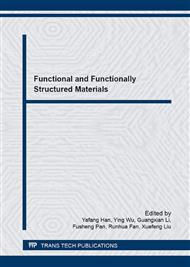[1]
Z.P. Shao, S.M. Haile, A high-performance cathode for the next generation of solid-oxide fuel cells, Nature. 431(2004) 170-173.
DOI: 10.1038/nature02863
Google Scholar
[2]
T. Norby, Solid-state protonic conductors: principles, properties, progress and prospects, Solid State Ionics. 125(1999) 1-11.
DOI: 10.1016/s0167-2738(99)00152-6
Google Scholar
[3]
B.C.H. Steele, A. Heinzel, Materials for fuel-cell technologies, Nature. 414 (2001) 345-347.
Google Scholar
[4]
K.D. Kreuer. Annu, Proton-conducting oxides, Rev. Mater. Res. 33 (2003) 333-359.
DOI: 10.1146/annurev.matsci.33.022802.091825
Google Scholar
[5]
H. Iwahara, T. Esaka, H. Uchida, N. Maeda, Proton conduction in sintered oxides and its application, Solid State Ionics. 3/4 (1981) 359-363.
DOI: 10.1016/0167-2738(81)90113-2
Google Scholar
[6]
H. Iwahara, H. Uchida, K. Ono, K. Ogaki, Proton conduction in sintered oxides based on BaCeO3, J. Electrochem. Soc. 135 (1988) 529-533.
DOI: 10.1149/1.2095649
Google Scholar
[7]
C. Chen, G.L. Ma, Proton conduction in BaCe1−xGdxO3−α at intermediate temperature and its application to synthesis of ammonia at atmospheric pressure, J. Alloys Compd. 485(2009) 69-72.
DOI: 10.1016/j.jallcom.2009.05.108
Google Scholar
[8]
L. Pelletier, A. McFarlan, N. Maffeiz, Ammonia fuel cell using doped barium cerate proton conducting solid electrolytes, J. of Power Sources. 145 (2005) 262-265.
DOI: 10.1016/j.jpowsour.2005.02.040
Google Scholar
[9]
E.C.C. de Souza, R. Muccillo, Properties and applications of perovskite proton conductors, Materials Research. 13(2010) 385-394.
DOI: 10.1590/s1516-14392010000300018
Google Scholar
[10]
N.I. Matskevich, Enthalpy of formation of BaCe0. 9In0. 1O3−δ, J. Therm. Anal. Calorim. 90(2007) 955-958.
DOI: 10.1007/s10973-007-8559-9
Google Scholar
[11]
L. Bi, S.Q. Zhang, L. Zhang, Z.T. Tao, H.Q. Wang, W. Liu, Indium as an ideal functional dopant for a proton-conducting solid oxide fuel cell, Int. J. Hydrogen Energy. 34(2009) 2421-2425.
DOI: 10.1016/j.ijhydene.2008.12.087
Google Scholar
[12]
M. Amsif, D. Marrero-Lopez, J.C. Ruiz-Morales, S.N. Savvin, M. Gabás, P. Nunez, Influence of rare-earth doping on the microstructure and conductivity of BaCe0. 9Ln0. 1O3−δ proton conductors, J. Power Sources. 196 (2011) 3461-3469.
DOI: 10.1016/j.jpowsour.2010.11.120
Google Scholar
[13]
L. Bi, S.Q. Zhang, S.M. Fang, Z.T. Tao, R.R. Peng, W. Liu, A novel anode supported BaCe0. 7Ta0. 1Y0. 2O3−δ electrolyte membrane for proton-conducting solid oxide fuel cell, Electrochem. Commun. 10(2008)1598-1601.
DOI: 10.1016/j.elecom.2008.08.024
Google Scholar
[14]
K. Xie, R.Q. Yan, X.Q. Liu, Stable BaCe0. 7Ti0. 1Y0. 2O3−δ proton conductor for solid oxide fuel cells, J. Alloys Compd. 479(2009) L40-L42.
DOI: 10.1016/j.jallcom.2009.01.011
Google Scholar
[15]
K. Xie, R.Q. Yan, X.X. Xu, X.Q. Liu, G.Y. Meng, The chemical stability and conductivity of BaCe0. 9−xYxNb0. 1O3−σ proton-conductive electrolyte for SOFC, Mater. Res. Bull. 44(2009)1474–1480.
DOI: 10.1016/j.materresbull.2009.02.015
Google Scholar
[16]
K. Xie, R.Q. Yan, X.Q. Liu, The chemical stability and conductivity of BaCe0. 9−xYxSn0. 1O3−δ solid proton conductor for SOFC, J. Alloys Compd. 479(2009) L36- L39.
DOI: 10.1016/j.jallcom.2008.12.120
Google Scholar
[17]
F. Genet, S. Loridant, G. Lucazeau, Vibrational normal modes of the phase of BaCeO3: a critical comparison of force fields, J. Raman Spectrosc. 28(1997) 255-276.
DOI: 10.1002/(sici)1097-4555(199704)28:4<255::aid-jrs95>3.0.co;2-f
Google Scholar
[18]
H.C. Gupta, P. Simon, T. Pagnier, G. Lucazeau, Force constant calculation from Raman and IR spectra in the three non-cubic phases of BaCeO3, J. Raman Spectrosc. 32(2001) 331-337.
DOI: 10.1002/jrs.700
Google Scholar


